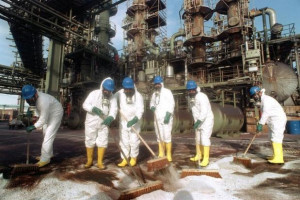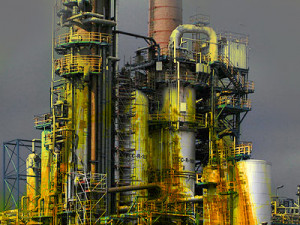At a chemical plant around 4:15 am, 2 tonnes of ortho-nitroanisole were released into the atmosphere, along with 5.5 tonnes of methanol, 0.2 tonnes of soda and 0.1 tonnes of ortho-chlorobenzene via safety valves subsequent to a pressure rise inside a reactor. An aerosol thrust by the wind headed towards the city. The plant, the banks of the MAIN RIVER and Frankfurt’s suburbs (located on the opposite riverbank) were all polluted by chemical products falling back to the ground, forming a sticky yellow-brown deposit. Several people were afflicted by breathing problems and rashes. Many malfunctions were recorded during the post-accident crisis management assessment; the company needed 4 to 5 days to decide on and coordinate an efficient cleanup campaign (stripping the ground or scraping and replacing the bitumen, removal of vegetation, etc.), whose cost would amount to 50 million francs.
Following an inspection, a technician had forgotten to turn the stirrer back on for the reactor heated at 95°C while a second reagent was being added. After a follow-up inspection conducted in accordance with the schedule listed in the operating procedure, the sample’s visual appearance did not match the expected specifications. The foreman ordered cooling the reactor. The technician carried out this order in noticing that the stirrer was idle and promptly turned it back on, which triggered a runaway reaction: pressure and temperature suddenly rose inside the reactor (from 9 to 16 bar / 95° to 155°C), causing the device’s safety valves to open.
Studies performed on this production process had underestimated the associated hazards:
- The characteristics of certain products had only been known for a short period of time (carcinogenic nature of o-nitroanisole, etc.).
- The installation was not equipped with servo-control mechanisms (stirrer, etc.).
- The instruments were protected from pressure surges by safety devices that lacked adequate collection facilities (roof runoff, etc.).
- The operating guidelines and procedures undoubtedly failed to fully incorporate process sensitivity (highly exothermic reaction, etc.).
This accident and others (ARIA 4374 and 4467) plus a number of incidents occurring over the next few weeks both at this plant and its subsidiaries were responsible for organising a vast safety control programme overhaul for chemical facilities in Germany’s HESSE State.





